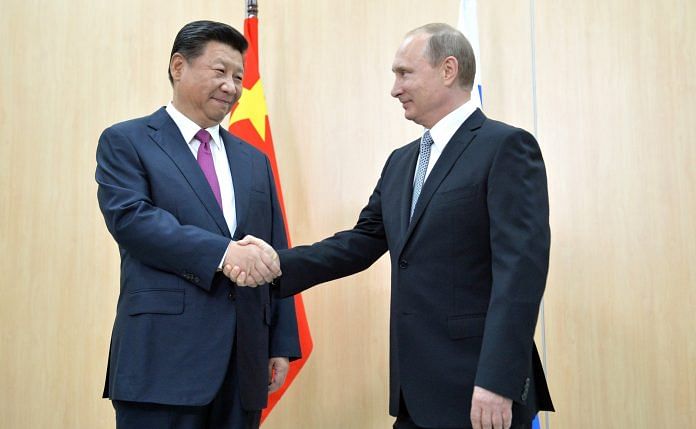The economic impact of the Russia-Ukraine war is making analysts question the stability of the Belt and Road Initiative. But there is something China has gained from the disruption. The war has brought Russia to the negotiating table. And now Beijing wants to move ahead with infrastructure projects in Central and West Asia, which were delayed because of the Kremlin’s hesitations.
China’s BRI has a new focus area—Eurasia. And Mongolia holds the key.
Construction work on the ‘Power of Siberia 2’ or the Altai gas pipeline project — connecting Siberian oil fields with China via Mongolia — will start in 2024, Mongolian Prime Minister Oyun-Erdene Luvsannamsrai told Financial Times on Monday. With Europe’s criticism of its member nations relying on Moscow’s energy supply, this gas pipeline project has become crucial for Russia’s state-owned Gazprom. The company’s chief Alexei Miller said China will become Russia’s primary customer of oil and gas in the future.
Chinese experts and social media users extensively discussed the Mongolian PM’s statement on the pipeline. Following his interview, the hashtag “China-Russia natural gas pipeline project to start construction in 2024” started trending on Weibo.
Also Read: India prepares for late-night military talks with China, and Beijing glams up Galwan survivor
Beyond Mongolia
Mongolia finds itself caught between Russia and China and might face difficulties in making a payment on bonds worth $1.3 billion scheduled to mature in 2023, and another $600 million due in 2024.
Though Russia and China had signed a $117.5 billion energy deal in February—right before Vladimir Putin launched his offensive on Kyiv—the impact of the Ukraine war has given Beijing new confidence to push ahead with its plans.
Chinese experts have proposed ways to mitigate the challenge posed by the Ukraine war. In most regions of the world, the BRI projects have struggled because of the pandemic and the war. “If the battlefield situation is prolonged, then the Belt and Road Initiative will need to be adjusted,” said Huang Renwei, executive vice dean of the Belt and Road and Global Governance Institute, Fudan University.
Also Read: Chinese are busy looking up ‘What does declaring bankruptcy mean’ after Sri Lanka crisis
China’s Eurasian dreams
Zhang Weiwei, the celebrity professor who has the ear of the top Chinese leadership, wants to promote connectivity across the Eurasian landmass to tip the balance of power.
“Today Eurasia hosts 75 per cent of the world’s population, 60 per cent of global GDP, and 75 per cent of known energy. China’s BRI and Russia’s ‘Greater Eurasian Partnership’ can radiate the entire Eurasian continent…I think it is the consensus of most countries in the Eurasian plate to promote cooperation between China and Russia in all aspects, to promote cooperation between different countries in the Eurasian plate and exchanges of civilizations, and to achieve win-win cooperation,” said Zhang during the “This is China” broadcast by Dragon TV.
The project in Mongolia isn’t the only one China is pushing for. After almost 20 years of negotiations, the construction of the China-Kyrgyzstan-Uzbekistan (CKU) railway will start in 2023. Though the proposed railway line will not pass through Russian territory, the countries have been Russia’s traditional backyard. And that’s where China is now trying to find an alternative passage for its supply chain. The CKU will act as a passage to Europe via Iran and Turkey, with a total length of 523 kilometres.
The new CKU railway project will revive the ‘Middle Corridor’ potential to Europe, which was earlier considered costly compared to the land route via Russian territory. The other component of the ‘Middle Corridor’ is Baku-Tbilisi-Kars (BTK) railway, which is another route that will heavily rely on Chinese suppliers to ship their cargo to Europe.
Moving cargo through Russian territory was one of China’s grand pivots under the BRI, but the war in Ukraine has made Beijing think about alternative routes to Europe. Chinese suppliers, however, are wary of sending cargo through Russian territory because of the sanctions imposed on the Kremlin.
Also Read: Don’t be surprised by China ignoring LAC at G20 meet. It’s a feature, not a bug
Alternatives to Russian territory
If Russia’s dependence on China increases, Beijing can swiftly roll out its geostrategic plans across Eurasia—overstepping Kremlin’s sphere.
“In this sense, we Chinese promote the development of the western region and the dual circulation of the national economy. We not only have a continental channel connecting the entire Eurasia, but also a coastline of 18,000 kilometres of the mainland,” said professor Weiwei.
Chinese experts have proposed a collaboration between Russia and China in the Eurasian region as a partnership of equals. But the war in Ukraine has left Russia with no other option but to give nod to projects China wants to implement. Kremlin has no leverage over Beijing, which will shrink Russia’s sphere of influence in its backyard.
The author is a columnist and a freelance journalist, currently pursuing an MSc in international politics with focus on China from School of Oriental and African Studies (SOAS), University of London. He was previously a China media journalist at the BBC World Service. He tweets @aadilbrar. Views are personal.
(Edited by Srinjoy Dey)



